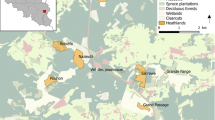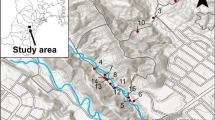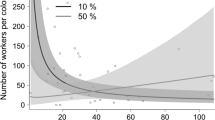Abstract
The number of both flowers and co-foragers may affect bumblebees’ local foraging decisions and the effort they devote to each flower during foraging. We studied bumblebees’ local foraging decisions by using an experimental set-up in which bumblebees (Bombus terrestris) foraged for a single species (Salvia farinacea) in patches containing S. farinacea and Tagetes bonanza in varying densities (25, 50 and 75 % Salvia). We did not restrict the number of co-foragers, which allowed us also to assess the influence of simultaneous and previous foragers on foraging decisions. Bumblebees could adjust the effort per inflorescence and flower to the number of available inflorescences and flowers in the patch. They increased between-patch and between-plant movements as the number of previous foragers increased, and this effect was stronger in the patches with more Salvia, probably due to the synergic effects of number of flowers and number of previous foragers. Simultaneous foragers, on the contrary, favoured within-plant movements. The probability of leaving a patch was positively related to inflorescence exploitation time and to the number of previous foragers. The movements between patches followed Salvia abundance and were modified by the experience gained in the observation period. This experiment shed light on the influence of foragers’ abundances on local foraging behaviour, and the interactions and synergies between flower abundance and foragers’ abundances at a local scale, which are still much unknown.







Similar content being viewed by others
References
Burns JG, Thomson JD (2006) A test of spatial memory and movement patterns of bumblebees at multiple spatial and temporal scales. Behav Ecol 17:48–55
Caruso CM (2002) Influence of plant abundance on pollination and selection on floral traits of Ipomopsis aggregata. Ecology 83:241–254
Chittka L, Thomson JD (2001) Cognitive ecology of pollination: animal behavior and floral evolution. Cambridge University Press, Cambridge
Chittka L, Gumbert A, Kunze J (1997) Foraging dynamics of bumblebees: correlates of movements within and between plant species. Behav Ecol 8:239–249
Cohen J (1988) Statistical power analysis for the behavioral sciences, 2nd edn. Lawrence Erlbaum Associates, Hillsdale
Cresswell JE (1990) How and why do nectar-foraging bumblebees initiate movements between inflorescences of wild bergamot Monarda fistulosa (Lamiaceae)? Oecologia 82:450–460
Cresswell JE (1997) Spatial heterogeneity, pollinator behaviour and pollinator-mediated gene flow: bumblebee movements in variously aggregated rows of oil-seed rape. Oikos 78:546–556
Dreisig H (1995) Ideal free distributions of nectar foraging bumblebees. Oikos 72:161–172
Dukas R, Real LA (1993) Effects of recent experience on foraging decisions by bumblebees. Oecologia 94:244–246
Feinsinger P, Murray KG, Kinsman S, Busby WH (1986) Floral neighborhood and pollination success in four hummingbird-pollinated cloud forest plant species. Ecology 67:449–464
Ghazoul J (2006) Floral diversity and the facilitation in pollination. J Ecol 94:295–304
Ghazoul J, Liston KA, Boyle TJB (1998) Disturbance-induced density-dependent seed set in Shorea siamensis (Dipterocarpaceae), and tropical forest tree. J Ecol 86:462–473
Giurfa M, Núñez JA (1993) Efficient floret inspection by honeybees in capitula of Carduus acanthoides. Ecol Entomol 18:116–122
Goulson D (2000) Why do pollinators visit proportionally fewer flowers in large patches? Oikos 91:485–492
Goulson D (2003) Bumblebees: behaviour and ecology. Oxford University Press, Oxford
Goulson D, Hawson SA, Stout JC (1998) Foraging bumblebees avoid flowers already visited by conspecifics or by other bumblebee species. Anim Behav 55:199–206
Goulson D, Chapman JW, Hughes WOH (2001) Discrimination of unrewarding flowers by different bee species; direct detection of rewards and use of repellent scent marks. J Insect Behav 14:669–678
Hegland SJ, Boeke L (2006) Relationships between the density and diversity of floral resources and flower visitor activity in a temperate grassland community. Ecol Entomol 31:532–538
Hegland SJ, Totland Ø (2005) Relationships between species’ floral traits and pollinator visitation in a temperate grassland. Oecologia 145:586–594
Hodges CM, Wolf LL (1981) Optimal foraging bumblebees: why is nectar left behind in the flowers? Behav Ecol Sociobiol 9:41–44
Jones KN, Reithel JS, Irwin RE (1998) A trade-off between the frequency and duration of bumblebee visits. Oecologia 117:161–168
Karron JD, Thumser NN, Tucker R, Hessenauer AJ (1995) The influence of population density on outcrossing rates in Mimulus ringens. Heredity 75:175–180
Lázaro A, Totland Ø (2010a) Local floral composition and the behaviour of pollinators: attraction to and foraging within experimental patches. Ecol Entomol 35:652–661
Lázaro A, Totland Ø (2010b) Population dependence in the interactions with neighbors for pollination: a field experiment with Taraxacum officinale. Am J Bot 97:760–769
Lázaro A, Aase ALTO, Totland Ø (2011) Relationships between densities of previous and simultaneous foragers and the foraging behaviour of three bumblebee species. Ecol Entomol 36:221–230
Motro U, Shmida A (1995) Near-far search: an evolutionary stable foraging strategy. J Theor Biol 173:15–22
Pyke GH, Cartar RV (1992) Flight directionality of bumblebees: do they know where they came from? Oikos 65:321–327
R Development Core Team (2008) R: a language and environment for statistical computing. R Foundation for Statistical Computing, Vienna, Austria. ISBN 3-900051-07-0, URL http://www.R-project.org
Raine NE, Chittka L (2007) The adaptive significance of sensory bias in a foraging context: floral colour preferences in the bumblebee Bombus terrestris. Plos One 2:e556
Rice WR (1989) Analyzing tables of statistical tests. Evolution 43:223–225
Sowig P (1989) Effects of flowering plant’s size on species composition of pollinator communities, foraging strategies, and resource partitioning in bumblebees (Hymenoptera: Apidae). Oecologia 78:550–558
Stat Soft Inc (2004) STATISTICA (data analysis software system), version 7. www.statsoft.com.
Stephens DW, Krebs JR (1986) Foraging theory. Monographs in behavior and ecology. Princeton University Press, Princeton
Stout JC, Goulson D, Allen JA (1998) Repellent scent marking of flowers by a guild of foraging bumblebees (Bombus spp.). Behav Ecol Sociobiol 43:317–326
Thomson JD, Maddison WP, Plowright RC (1982) Behaviour of bumblebee pollinators on Aralia hispida Vent. (Araliaceae). Oecologia 54:326–336
Waser NM (1986) Flower constancy: definition, cause, and measurement. Am Nat 127:593–603
Wetherwax PB (1986) Why do honeybees reject certain flowers. Oecologia 69:567–570
Williams CS (1998) The identity of the previous visitor influences flower rejection by nectar-collecting bees. Anim Behav 56:673–681
Witjes S, Eltz T (2007) Influence of scents deposits on flower choice: experiments in an artificial flower array with bumblebees. Apidologie 38:12–18
Zimmerman M (1983) Plant reproduction and optimal foraging: experimental nectar manipulations in Delphinium nelsonii. Oikos 41:57–63
Zuur AF, Ieno EN, Walker NJ, Saveliev AA, Smith GM (2009) Mixed effects models and extensions in ecology with R. Springer, New York
Acknowledgments
We thank Alberto Díaz and Antón Pérez for their invaluable help during the experiment. Thanks also to the Norwegian University of Life Sciences for allowing the use of one of their greenhouses and Ørjan Totland for facilitating the logistics. This study was supported by the project 170532/V40, financed by the Norwegian Research Council. During the writing of this manuscript, AL was supported by a Juan de la Cierva contract, financed by the Spanish Ministry of Science and Innovation, and MP was supported by a JAE predoc contract, financed by the Spanish Council for Scientific Research.
Author information
Authors and Affiliations
Corresponding author
Rights and permissions
About this article
Cite this article
Lázaro, A., Piazzon, M. Influence of number of flowers and number of previous and simultaneous foragers on bumblebees’ local foraging decisions. acta ethol 18, 37–46 (2015). https://doi.org/10.1007/s10211-014-0180-x
Received:
Revised:
Accepted:
Published:
Issue Date:
DOI: https://doi.org/10.1007/s10211-014-0180-x




